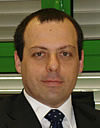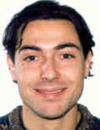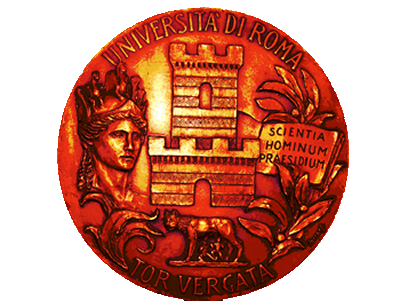ELECTRICAL NETWORK ANALYSIS - 9 ECTS
Sargeni (2011-2017)
Vincenzo Bonaiuto 2019
Program didatticaWeb
MATHEMATICAL ANALYSIS II - 9 ECTS
Michiel Bertsch
Morsella Gerardo, Yoh Tanimoto (2017-18)
Yoh Tanimoto Butterfly Oliver James (2019-20)
Teaching Assistant: Dr. Daniele Castorina
| |
1 Sequences, infinite series, improper integrals, Ch. 10
2 Sequences and series of functions, Ch. 11
Apostol Volume 2:
3 Differential calculus of scalar and vector fields, Ch. 8
4 Applications of di�erential calculus, Ch. 9
5 Line integrals, Ch. 10
6 Multiple integrals, Ch. 11
7 Surface integrals, Ch. 12
8 Di�erential equations (to be decided) |
Reference book: Tom M. Apostol, Calculus, Volumes 1and 2. Apostol Volume 1
PHYSICS II - 9 ECTS
Giuseppe Balestrino - Teaching Assistant: Federico Ridolfi
Vittorio Foglietti (2019)
Electric charges, Coulomb’s law, continuous charge distribution, the electric field, the electric field o point charges, electric field of continuous charge distributions, electric field lines, the dipole, field generated by a dipole, the flux of the electric field, Gauss law, applications of the gauss law, electric potential energy, electric potential, calculating field and potential, electrical properties of materials, Ohm’s law: a microscopic view, capacitance, calculating the capacitance, capacitors in series and parallel, capacitors with dielectric, electric current, resistance, resistors in series and parallel, charge and discharge of a capacitor, the magnetic field, the magnetic force on a moving charge, the Hall effect, magnetic force on a current carrying wire, the torque on current loop, the magnetic field due to a moving charge, the magnetic field of a current, the solenoid, Ampere’s law, faraday’s law of induction, Lenz’ law, motional emf, inductance, magnetic properties of materials, magnetization, paramagnetism, diamagnetism, ferromagnetism, Maxwell’s equations, electromagnetic waves, energy transport and the Poynting vector, the electromagnetic spectrum, introducing the photon concept, photoelectric effect. Particles as waves: the de Broglie relation. The Schrödinger equation: time dependent and time independent. The free particle. Quantum well and tunnel effect. The Fermi gas. Origin of bands in metals.
Reference book: Physics, Volume 2
Halliday, Resnick, Krane,
Wiley
ANALOGUE ELECTRONICS - 9 ECTS
Paolo Colantonio e Rocco Giofre'

Classification of electrical systems and requirements. Analysis of transitory and frequency behaviour. Distortion in electronic systems and Bode diagrams. Diode semiconductor devices and circuit applications: clipper, clamper, peak detector, etc. Bipolar Junction and Field Effect Transistors. Biasing techniques for Transistors. Amplifiers classification, analysis and circuit design. Frequency response of single and cascaded amplifiers. Differential amplifiers and Cascode. Current mirrors. Feedback amplifiers and stability issues. Power amplifiers. Operational amplifiers and related applications. Oscillator circuits. Integrated circuits and voltage waveform generators.
Reference book:
FEEDBACK CONTROL SYSTEMS - 9 ECTS
Cristiano Maria Verrelli
Teaching Assistant: Ing. Stefano Scalzi
 The theory of differential equations can be successfully used to gain profound insight into the fundamental mathematical control design techniques for linear and nonlinear dynamical systems. Tutor-guided individual projects (including computer simulations and lab experiments) invite an intensive participation. The theory of differential equations can be successfully used to gain profound insight into the fundamental mathematical control design techniques for linear and nonlinear dynamical systems. Tutor-guided individual projects (including computer simulations and lab experiments) invite an intensive participation.
- Linear systems
The matrix exponential; the variation of constants formula. Computation of the matrix exponential via eigenvalues and eigenvectors and via residual matrices. Necessary and sufficient conditions for exponential stability: Routh-Hurwitz criterion. Invariant subspaces. Impulse responses, step responses and steady state responses to sinusoidal inputs. Transient behaviors. Modal analysis: mode excitation by initial conditions and by impulsive inputs; modal observability from output measurements; modes which are both excitable and observable. Popov conditions for modal excitability and observability. Autoregressive moving average (ARMA) models and transfer functions.
Kalman reachability conditions, gramian reachability matrices and the computation of input signals to drive the system between two given states. Kalman observability conditions, gramian observability matrices and the computation of initial conditions given input and output signals. Equivalence between Kalman and Popov conditions. Kalman decomposition for non reachable and non observable systems.
Eigenvalues assignment by state feedback for reachable systems. Design of asymptotic observers and Kalman filters for state estimation of observable systems. Design of dynamic compensators to stabilize any reachable and observable system. Design of regulators to reject disturbances generated by linear exosystems.
Introduction to adaptive control. Introduction to tracking control. Minimum phase systems and proportional Integral Derivative (PID) control.
Bode plots. Static gain, system gain and high frequency gain. Zero-pole cancellation. Nyquist plot and Nyquist criterion. Root locus analysis. Stability margins. Frequency domain design. Realization theory.
- Introduction to nonlinear systems
Nonlinear models and nonlinear phenomena. Fundamental properties. Lyapunov stability. Linear systems and linearization. Center manifold theorem. Stabilization by linearization. Control mechanisms, bifurcation phenomena, complexities and subtleties in biology and physiological processes.
Reference books:
C.M.Verrelli. La matematica elementare del feedback, III Edizione. Esculapio, 2015.
H. Klee, R. Allen. Simulation of Dynamic Systems with MATLAB and Simulink, Second Edition, CRC Press, 2011.
G.F. Franklin, J.D. Powell, A. Emami-Naeini, Feedback control of dynamic systems, VI Edizione. Pearson.
Michael E. Taylor. Introduction to Differential Equations. American Mathematical Society, 2011.
M.W. Hirsch, S. Smale, R.L. Devaney. Differential equations, dynamical systems & an introduction to chaos. Elsevier, Academic Press, 2004.
Richard C. Dorf, Robert H. Bishop. Modern Control Systems. Prentice Hall, 2011.
K.J.Astrom, R. Murray. Feedback systems. An introduction for scientists and engineers. Princeton University Press, 2008.
L.A. Segel, L. Edelstein-Keshet, A Primer on Mathematical Models in Biology, Cambridge University Press, 2013.
Tutor-guided individual projects (including computer simulations) are involved and may concern one of the following topics.
- L. Edelstein-Keshet, Mathematical models in biology, Siam, 2005.
- J. D. Murray, Mathematical biology I, Springer, 2003.
- D. S. Jones, M. J. Plank, B. D. Sleeman, Differential equations and mathematical biology, CRC press, 2010.
- Mathematics of heart physiology and control
- D. S. Jones, M. J. Plank, B. D. Sleeman, Differential equations and mathematical biology, CRC press, 2010.
- J. Keener, J. Sneyd, Mathematical physiology, Springer, 2004.
- M. C. K. Khoo, Physiological control systems, IEEE press, 2000.
- Mathematics for glucose regulation control
- J. Keener, J. Sneyd, Mathematical physiology, Springer, 2004.
- M. C. K. Khoo, Physiological control systems, IEEE press, 2000.
Syllabus
MECHANICS OF MATERIALS AND STRUCTURES - 9 ECTS
Giuseppe Tomassetti (2017)
Micheletti Andrea, Artioli Edoardo
Force Systems, Equilibrium of a Rigid Body, Free-body Diagrams, Stress and Strain, Axial Load, Torsion, Bending, Shear, Design and Analysis of Trusses and Frames, Buckling of Columns.
Reference books: R. C. Hibbeler, Statics and Mechanics of Materials, Third Edition.
Syllabus
THERMODYNAMICS AND HEAT TRANSFER - 9 ECTS
Paolo Coppa
Teaching Assistant: Dr. Gianluigi Bovesecchi

Time distribution: 56 hours for lectures, 30 hours for applied exercises, 4 hours for progress tests, 90 hours of individual work.
Teacher’s name: Paolo Coppa
Educational goals: To achieve a technical and scientific basis in the field of thermodynamics, fluid dynamics and heat transfer.
Prerequisites: Basic calculus, Solution of linear differential equations, Basic physics.
Course syllabus:
Fundamental laws of thermodynamics. Thermodynamic diagrams. Thermodynamic cycles for close and open systems. Air and steam mixtures. Basic laws of fluid dynamics. Heat transfer mechanisms: conduction, convection, and radiation heat transfer. Heat exchangers.
Reference books:
- M.W.Zemanski, M.M. Abbott, H.C. Van Ness, Beasic Engineering Thermodynamics, Mc-Graw Hill Inc. !975
- I.P.Holman, Heat Transfer, Mc. Graw Hill Int. 1981
- any other equivalent book
Syllabus |
 University of Rome Tor Vergata
University of Rome Tor Vergata 

 The theory of differential equations can be successfully used to gain profound insight into the fundamental mathematical control design techniques for linear and nonlinear dynamical systems. Tutor-guided individual projects (including computer simulations and lab experiments) invite an intensive participation.
The theory of differential equations can be successfully used to gain profound insight into the fundamental mathematical control design techniques for linear and nonlinear dynamical systems. Tutor-guided individual projects (including computer simulations and lab experiments) invite an intensive participation. 
